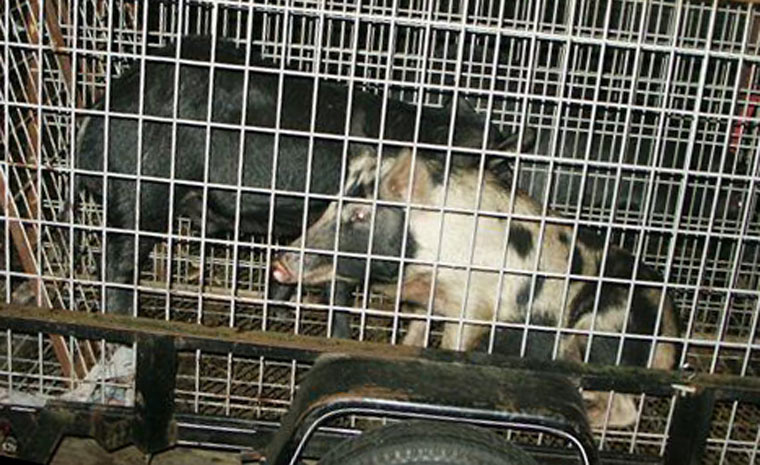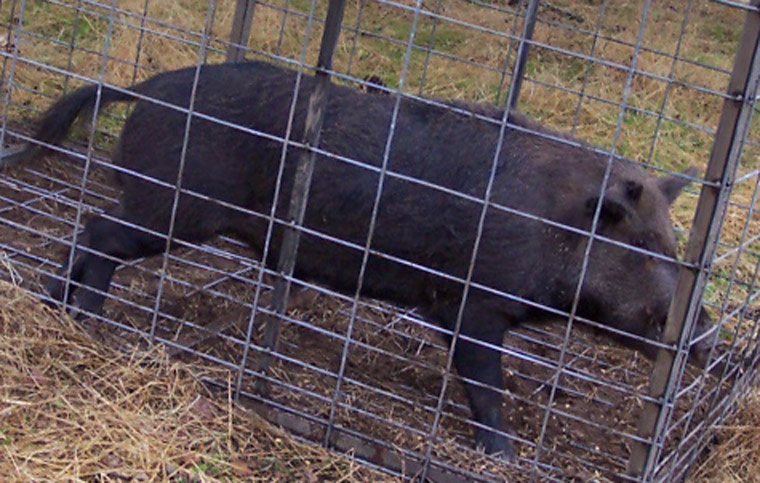-
info@aaanimalcontrol.com
Call us for help in your town
Humane Wildlife Education
Trapping feral hogs
Need hog removal in your hometown? We service over 500 USA locations! Click here to hire us in your town and check prices - updated for year 2020.
Feral hogs are very aggressive animals that can be quite dangerous to be able and their pets. They are not only large animals, but also are able to get up a great deal of speed, often being able to out run a human being. This means that if they have you or your children in their sites then there can be very serious consequences.

Many take the steps to try to keep these animals away by putting up such things as fences or using commercial repellents to try to deter them from coming onto their land, but these can prove to be ineffective, meaning a different alternative is needed in this situation. This is where the idea of trapping a feral hog may be the best option for you.
Before deciding to trap this animal, there are a couple of factors that you need to take into consideration. First of all, you must understand that once the animal is trapped it does not become tame. These are very aggressive hogs, which will do all that they can to try to get out of the cage. Simply trying to pick up the cage and move it to another location to let the animal go poses its risks to it.
With this in mind, the best way to trap a feral hog is by buying one of the commercial traps that is geared towards capturing larger animals. If you have not seen one of these, there are cages that can be used to catch such things as foxes, coyotes, wolves, and these kinds of hogs. They are built of a very sturdy metal, which can withstand the battering and abuse from the animal as it tries to get free.
In addition, these cages are built so that the animal can get inside but is in getting back out. The doors are built with a great deal of strength, which is necessary in your desire to be able to keep the feral hog at bay. If this animal is captured, it has a great deal of strength to bat or its way out, but a good commercial cage will deny it that ability.
To lure the hog into your cage, it is important to make sure that the bait is something that it will go after. A feral hog will eat lots of different kinds of food, but it is a big fan of things like vegetables. Place a pile of these in the cage and you can be sure that the hog will come after it.
As one important note before making your decision to place your trap to capture this animal, consider that you want to place the trap as far away from your home as possible. While you want to put it in a location where the animal is known to go, it is also a good idea to keep it far away. This ensures that your pets and your children may not inadvertently come around the cage when the animal is inside.
How to Trap Feral Hogs
Need wildlife removal in your hometown? We service over 500 USA locations! Click here to hire us in your town and check prices- updated for year 2020.
Did you know that feral hogs could carry and transmit as many as twenty different species of parasitic worm? Not just that, hogs can also carry no fewer than fifteen different diseases. They can both pass on and carry swine flu, but they can't actually contract it themselves, quite the opposite to what you may have read or heard. As well as this, feral hogs can also be very angry and aggressive creatures, inflicting injuries on other animals and even other humans that could end up being life-threatening. During the mating seasons, males are even more aggressive than they would usually be, and it is during this months that human-hog contact could prove deadly. November, December and January are the more dangerous months.

As well as being rather aggressive, feral hogs tend to be quite large. This poses your first problem when it comes to learning how to trap feral hogs. You're going to need one hell of a trap, and it's going to need to be very strong too.
Feral hogs tend to follow the same patterns day in, day out, and this makes working them out, and working out how to trap them, a much easier process. It will only take a few days for you to work out their regular routine, and once you have that — the paths they travel the most, etc., — you can then protect your property much more effectively.
Cages are better than fenced-in enclosures, and there have been reports of feral hogs being about to jump their way out of traps with barriers that are close to two meters in height. These creatures are incredibly smart, and they will even crawl up on top of each other in order to break free.
The more hogs you think you have, the bigger the trap you'll need. These creatures have a habit of following each other, so with the right bait and the right size trap, trapping them should be easier. You will also need to figure out the right places to put your trap or traps, but tracking the creatures and figuring out their routine, just like we suggested earlier, will help with that too. By watching the animals, you'll get a good idea of where they hang out the most, and also which routes are the most used between different places.
As well as a strong, reliable, and well-thought-out trap, you will also need the perfect bait. Feral hogs have shown to love overripe fruit, so this is a very goo place to start and also gives you a way to finally get rid of that fruit bowl full of starting-to-go-bad fruit that you keep promising yourself you'll eat. The stronger and sweeter the smell, the more these hogs will come running, and the best fruits for that include delights such as strawberries. You can also buy hog bait which is generally a very sweet makeup of various things. The best way to approach the bait issue is to look at what pungent and sweet-smelling foods are NOT available in the area local to you. If the hogs can already find the bait in the wild, it will be less inclined to go into the trap. You're going to need to give up the good stuff in order to lure these smart hogs in.
Once you have captured the feral hog(s), you then have the issue of what to do next. This isn't exactly the kind of animal that you can just throw in the back of your vehicle, drive for a few miles, and then release again. You will need to make sure you know the rules and legislations in your state before you take any action, of course, as may find that you will need to destroy the hog after you've captured it.
For more information, you may want to click on one of these guides that I wrote:
How To Guide: Who should I hire? - What questions to ask, to look for, who NOT to hire.
How To Guide: do it yourself! - Advice on saving money by doing wildlife removal yourself.
Guide: How much does wildlife removal cost? - Analysis of wildlife control prices.
Animals in the attic - read about the common species.
Noises in the attic - how to identify critters by their sounds.


















